Students share work at Troutbeck Symposium

Students presented to packed crowds at Troutbeck.
Natalia Zukerman

Students presented to packed crowds at Troutbeck.
The third annual Troutbeck Symposium began this year on Wednesday, May 1 with a historical marker dedication ceremony to commemorate the Amenia Conferences of 1916 and 1933, two pivotal gatherings leading up to the Civil Rights movement.
Those early meetings were hosted by the NAACP under W.E.B. Du Bois’s leadership and with the support of hosts Joel and Amy Spingarn, who bought the Troutbeck estate in the early 1900s.
Students from Arlington High School in LaGrange, New York, Kara Gordon, Nicolas Giorgi, Justin Meneses Aquimo, Akhil Olahannan, and Sheik Bowden together with their teacher Robert McHugh, made the historical marker possible by pursuing a grant from the Pomeroy Foundation.
“We believe strongly that markers help educate the public, encourage pride of place, and promote historical tourism,” said the foundation’s research historian and educational coordinator.
The ceremony began with a land acknowledgement by students Kennadi Mitchell and Teagan O’Connell from Salisbury Central School who gave thanks to the Muncie Lenape, Mohican and Schagticoke people by saying, “This guardianship has brought us to this very moment where we may learn from one another. We honor and respect the continuing relationship that exists between these peoples and this land.”
The crowd was then welcomed by Charlie Champalimaud who, with her husband, Anthony are the current owners of Troutbeck. Speeches were then given by Kendra Field and Kerri Greenridge, co-hosts of the event and founders of The Du Bois Forum, an annual retreat of writers, scholars, and artists engaged in historic Black intellectual and artistic traditions.
Field noted, “It is our genuine hope that the dedication of new historical sites, most especially this one, as part of our larger commitments, will make more complex, more diverse, and more complete the answer to the simple question ‘what happened here?’ and the closely related question, “what might happen next for generations to come?’”
MaryNell Morgan enchanted the audience with her a capella renditions of several of Du Bois’s “Sorrow Songs.”
Du Bois used these songs as part of the presentation of his 14 essays in his seminal work “The Souls of Black Folk,” first published in 1903.
A graduate of Atlanta University where Du Bois taught twice, Morgan sang a medley of songs explaining that the best way to understand “The Souls of Black Folk” is to understand the songs. In attendance at the evening event were also local officials, Amenia Town Supervisor Leo Blackman, and New York Assembly Members Didi Barrett and Anil Beephan. Closing remarks were given by Hasan Kwame Jeffries, Associate Professor at Ohio State University and one of the panelists for the Symposium.
Over the next two days, more than 200 middle and high school students from 16 regional public and independent schools converged to present and discuss their year-long research projects, uncovering the often-overlooked local histories of communities of color and other marginalized groups, answering the questions posed the night before, “what happened here and what might happen next for generations to come?”
Rhonan Mokriski, history teacher and educational director for the Troutbeck Symposium, emphasized the student-led nature of the forum by saying the directive was to “give it to the students and let them run with it.”
Through visual art, documentaries, personal and historical narrative, photographs, and multiple forms of storytelling, students skillfully presented their findings, revealing truths— often difficult ones—in the tradition of their predecessors who did so in the very same location.
Said Jeffries, “It’s one thing if the kids were doing research and then presenting in the, let’s say, school gymnasium, right? But to be able to do it here at Troutbeck, it adds the power of place and makes it all the more powerful.”
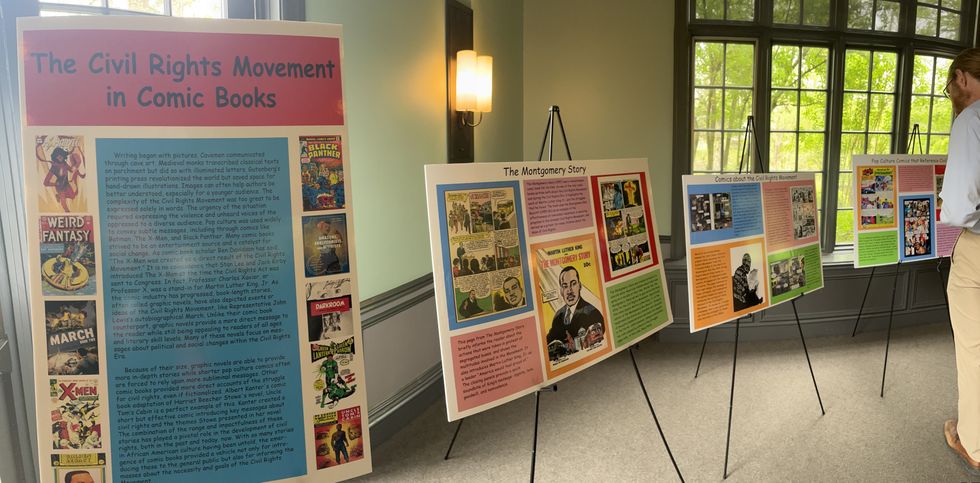
Student presentations ranged in topics from the Silent Protest of 1917 and its connection to the Amenia conference of 1916, the links between Lorraine Hansberry, Langston Hughes and Nina Simone, to local families, Amy Spingarn’s quiet activism, reimagining Du Bois’s ‘The Crisis’ through a modern contextualization that included the recent Supreme Court action on Affirmative Action.
Jeffries and Christina Proenza-Coles, a professor at Virginia State University spoke after each set of presentations, responding to and contextualizing the students’ work.
“These projects themselves are commemorations,” Poenza-Coles said. “They are themselves peaceful protests that are pointing us to a more just future.” Poenza-Coles emphasized the interconnectedness of past and present and stated, “Spaces that we would have thought about as white spaces, in fact, were also black and brown spaces from the beginning of history. Histories are completely intertwined.”
Blake Myers, programming, marketing, and culture manager at Troutbeck spoke passionately about the community effort it takes to put on the event year after year. She said that while making sure the program is sustainable, “It really is a replicable model,” and hopes to see other institutions, schools, and foundations adopt it as a teaching tool.
The rooms, walls, and wooded paths of Troutbeck reverberated for three days with stories, past and present, celebrations and revelations of untold narratives and marginalized voices.
Said Jeffries, “America is a product of decisions and choices that were made, and often those were bad decisions and bad choices from the perspective of somebody committed to human rights and to equality. But that’s our foundation, that’s how we started this whole thing.
“So, you have that on the one hand, but then despite the systems of oppression that are designed to do just that, you always have people willing to fight against it and people who are willing to carve out spaces to preserve, promote and protect their own humanity.”
Left to grapple with the complexities of historical memory and its implications for contemporary society, Jeffries offered, “The work that’s being done here, connected with Troutbeck, it’s not just about recovery and discovery, which is critical. But then the question is what do you do with it (the information)? How do we commemorate?
“What do we put in place physically so that we don’t forget. Often, we think about history and this question of ‘if you don’t remember the past, if you don’t remember the systems that are created, then we are doomed or bound to repeat it.’ But we’re not going to repeat anything because most of the stuff, we never stopped doing.”
There was some laughter from the audience and Jeffries concluded, speaking to the students, “But you’re waking up, remembering, focusing, and bearing witness so that we can finally disrupt it. We can finally stop doing the things from the past that have created and generated inequality in the present by focusing on this community that is very much doing the work.”
Recount Moderator Rosemary Keilty, at right, leads the team of poll workers during the recount in North Canaan Town Hall Monday, Nov. 10.
NORTH CANAAN — A recount held Monday, Nov. 10, at Town Hall confirmed Democrat Jesse Bunce’s narrow victory over incumbent First Selectman Brian Ohler (R) in one of the tightest races in town history.
“A difference of two votes,” said recount moderator Rosemary Keilty after completing the recanvass, which finalized the tally at 572 votes for Bunce and 570 for Ohler.
“It’s overwhelming,” said Bunce after the result. To the poll workers he said, “Thank you everyone for your hard work. It’s been an honor.” And he thanked Ohler for his service to the town.
The two men shook hands.
“Congratulations,” said Ohler. “Wish you all the best. When you succeed, the Town of North Canaan succeeds and that’s why we’re all here.”
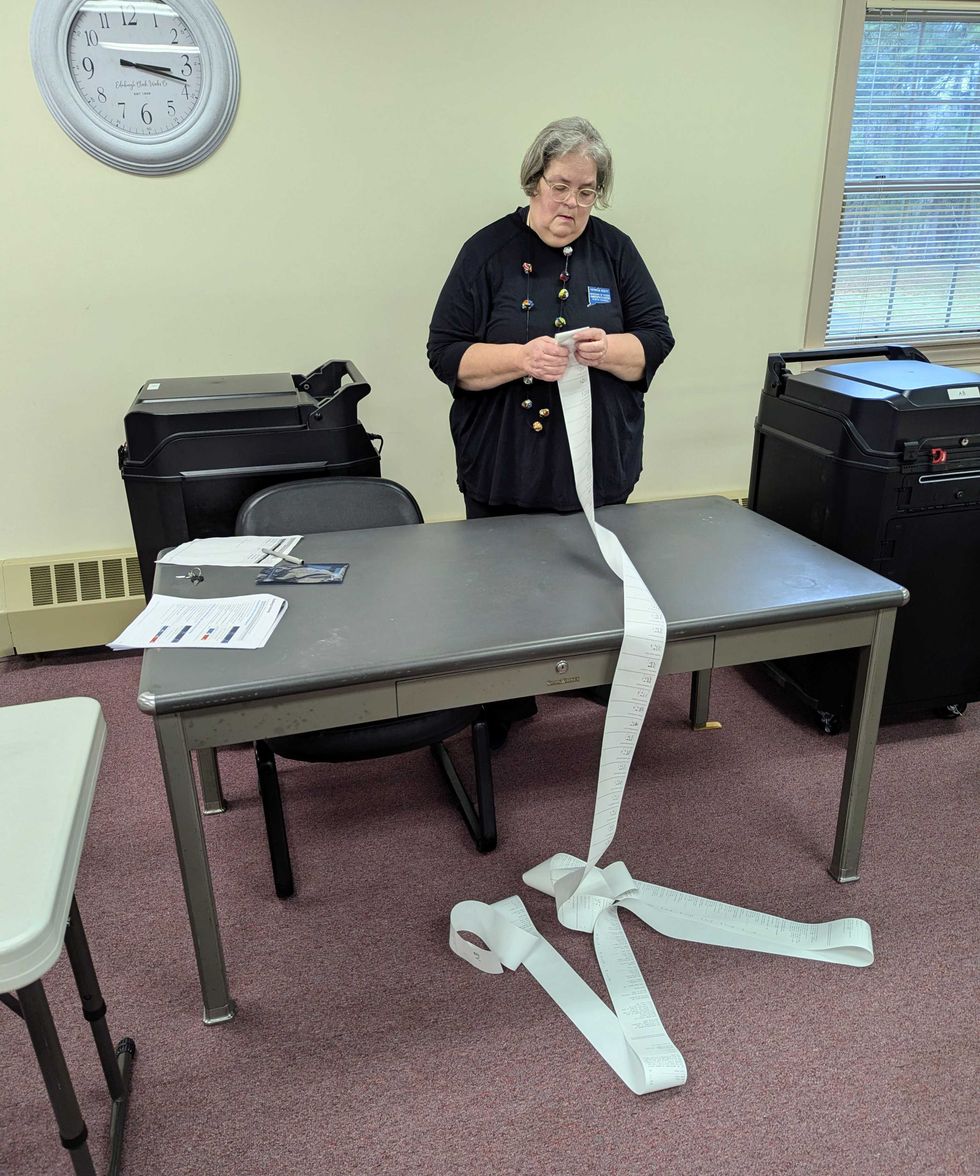
Ohler will continue on the board as a selectman. Newcomer Melissa Pinardi (R) will fill the third seat on the board.
The recount was required by state law after the initial count on Election Day showed a difference of three votes (572 to 569).
Ohler gained one vote in the recount and Bunce’s total was unchanged. Keilty said the extra vote was likely from a ballot that the tabulator did not read properly last Tuesday.
There was a single ballot that was not counted because the voter selected both Ohler and Bunce for first selectman.
Looking ahead to the coming term, Bunce said he was ready to get to work. “We have a good game strategy of how we’d like to handle the first 90 days and I look forward to executing that,” he said. “I think we can do lots of fun, exciting things for the town that’ll benefit all sorts of people.”
In a follow up statement, Ohler wrote, “The future of North Canaan is bright.” He continued, “Now is not the time to wish failure or misstep upon any elected official. We will all serve each other and our town, just as your votes intended them to do. It has been an immense honor to serve as your First Selectman... We are North Canaan.”
The first meeting of the new Board of Selectmen will be held in Town Hall Monday, Dec. 1, at 7 p.m.
photo by ruth epstein
KENT – The cold temperatures and biting winds didn’t deter a crowd from gathering for the annual Veterans Day ceremony Tuesday morning, Nov. 11.
Standing in front of the memorials honoring local residents who served in the military, First Selectman Martin Lindenmayer, himself a veteran, said the day is “not only a time to remember history, but to recognize the people among us—neighbors, friends and family—who have served with courage, sacrifice and devotion. Whether they stood guard in distant lands or supported their comrades from home, their service has preserved the freedoms we enjoy each day.”
While veterans live by the words duty, honor, country, said Lindenmayer, it doesn’t mean they are warmongers. “The soldier, above all, prays for peace.” He told the veterans the town is proud of them. “We pledge to honor your service not only with words, but with our actions—by building a community and a country worthy of your sacrifice.”
Brent Kallstrom, commander of Hall-Jennings American Legion Post 153, gave a message from the American Legion in which he said Veterans Day can be traced to the armistice that ended World War I.
“For many veterans, our nation was important enough to endure long separations from their families, miss the births of their children, freeze in sub-zero temperatures, bake in wild jungles, lose limbs and far too often, lose their lives,” he said.
He noted that fewer than 10% of Americans can claim the title veteran and less than one half of 1% of the population currently serves.
“Veterans have given us freedom, security and the greatest nation on earth,” said Kallstrom. “It is impossible to put a price on that.”
Local veterans shot three rounds and bagpiper Don Hicks provided music. The Rev. John Heeckt of the Kent Congregational Church gave the invocation and the Rev. Richard Clark of St. Andrew’s Episcopal Church gave a concluding prayer.
Members of St. Andrew’s then hosted a luncheon for all veterans and their families.
Ava Segalla, Housatonic Valley Regional High School's all-time leading goal scorer, has takes a shot against Coventry in the Class S girls soccer tournament quarterfinal game Friday, Nov. 7.
FALLS VILLAGE — Housatonic Valley Regional High School’s girls soccer team is headed to the semifinals of the state tournament.
The Mountaineers are the highest seeded team of the four schools remaining in the Connecticut Interscholastic Athletic Conference Class S playoff bracket.
HVRHS (3) will play Morgan High School (10) in the semifinals. On the other side of the bracket, Canton High School (4) will play Old Saybrook High School (9). The winners of both games will meet in the Class S championship game.
To start the tournament, HVRHS earned a first-round bye and then had home-field advantage for the second-round and quarterfinal games.
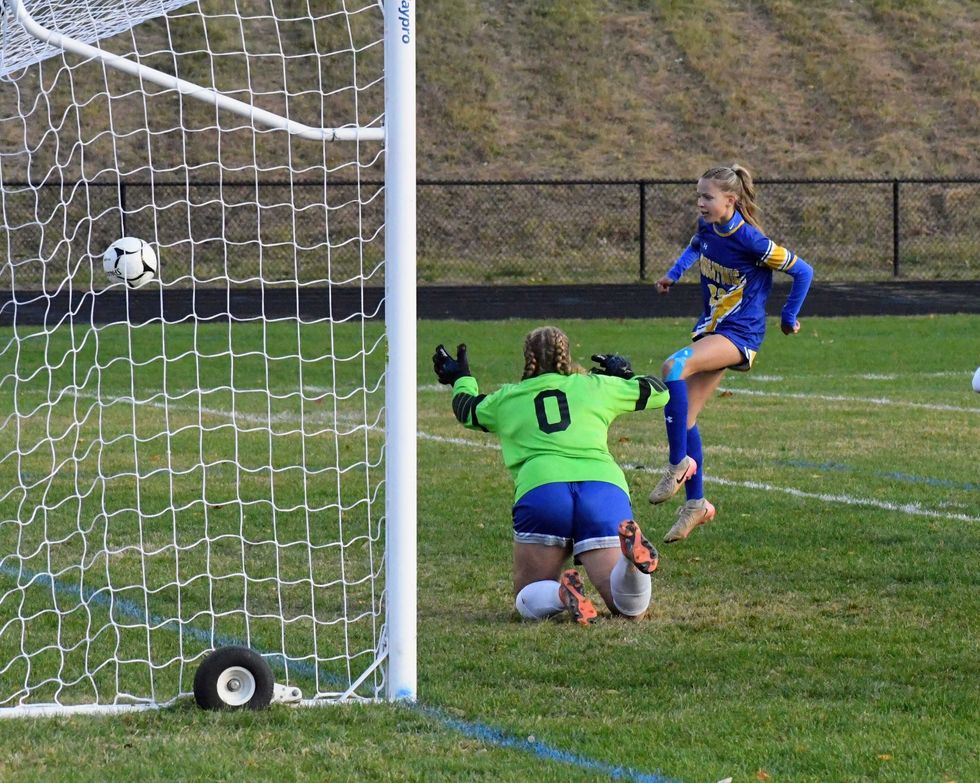
In the second round Tuesday, Nov. 4, HVRHS won 4-3 against Stafford High School (19) in overtime. Ava Segalla scored three goals for Housatonic, including the overtime winner, and Lyla Diorio scored once. Bella Coporale scored twice for Stafford and Gabrielle Fuller scored once.
HVRHS matched up against Coventry High School (11) in the quarterfinal round Friday, Nov. 7. In the 2024 tournament, Coventry eliminated the Mountaineers in the second round.
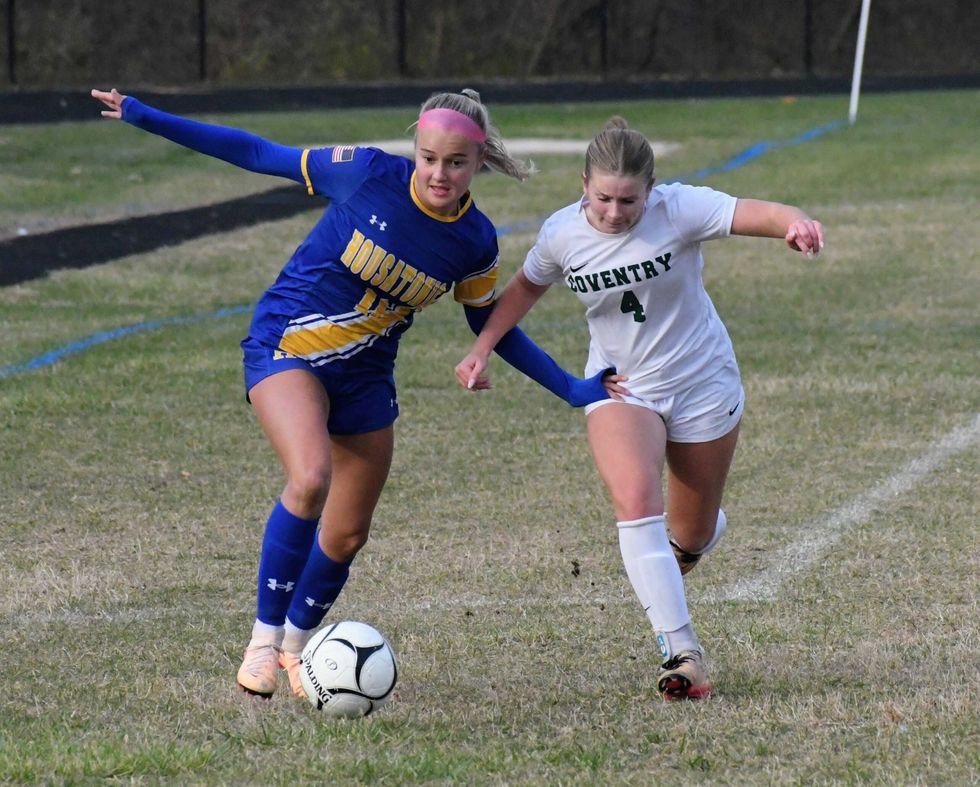
Revenge was served in 2025 with a 4-2 win for HVRHS. Segalla scored her second hat trick of the tournament and Georgie Clayton scored once. Coventry’s goals came from Jianna Foran and Savannah Blood.
“The vibes are great,” said HVRHS Principal Ian Strever at the quarterfinal game.
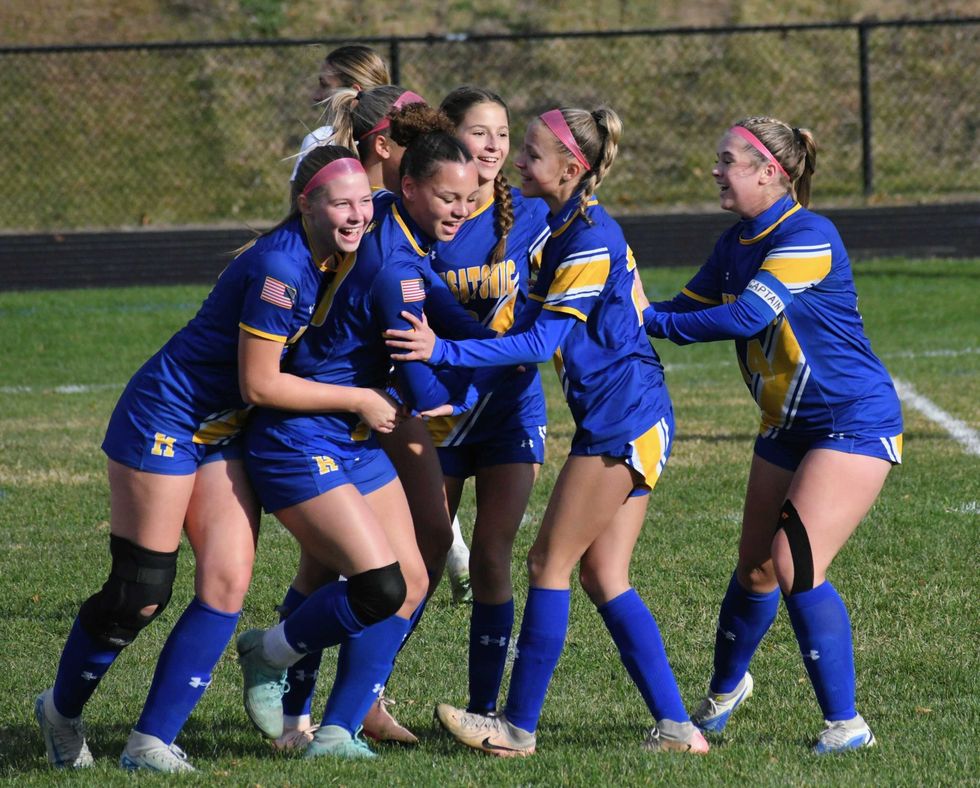
The semifinal against Morgan will be played Wednesday, Nov. 12, on neutral ground at Newtown High School.
If HVRHS wins, it will mark the girls soccer team’s first appearance in the Class S title game since 2014.
Morgan was the runner-up in last year’s Class S girls soccer tournament, losing in penalty kicks to Coginchaug High School.
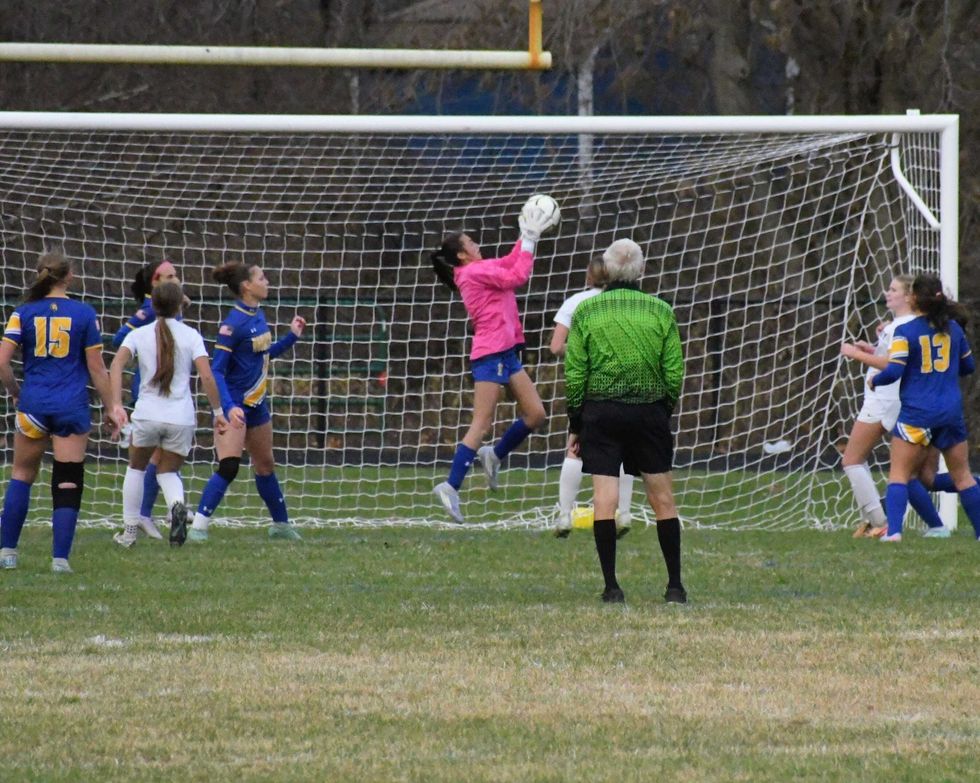
Legal Notice
The Planning & Zoning Commission of the Town of Salisbury will hold a Public Hearing on Special Permit Application #2025-0303 by owner Camp Sloane YMCA Inc to construct a detached apartment on a single family residential lot at 162 Indian Mountain Road, Lakeville, Map 06, Lot 01 per Section 208 of the Salisbury Zoning Regulations. The hearing will be held on Monday, November 17, 2025 at 5:45 PM. There is no physical location for this meeting. This meeting will be held virtually via Zoom where interested persons can listen to & speak on the matter. The application, agenda and meeting instructions will be listed at www.salisburyct.us/agendas/. The application materials will be listed at www.salisburyct.us/planning-zoning-meeting-documents/. Written comments may be submitted to the Land Use Office, Salisbury Town Hall, 27 Main Street, P.O. Box 548, Salisbury, CT or via email to landuse@salisburyct.us. Paper copies of the agenda, meeting instructions, and application materials may be reviewed Monday through Thursday between the hours of 8:00 AM and 3:30 PM at the Land Use Office, Salisbury Town Hall, 27 Main Street, Salisbury CT.
Salisbury Planning & Zoning Commission
Martin Whalen, Secretary
11-06-25
11-13-25
Notice of Decision
Town of Salisbury
Planning & Zoning Commission
Notice is hereby given that the following action was taken by the Planning & Zoning Commission of the Town of Salisbury, Connecticut on October 20, 2025:
8-24 referral was deemed consistent with the Plan of Conservation and Development - For the use of town-owned land at 20 Salmon Kill Road, Salisbury for housing, recreation, and conservation. The property is shown on Salisbury Assessor’s Map 11 as Lot 26.
Any aggrieved person may appeal these decisions to the Connecticut Superior Court in accordance with the provisions of Connecticut General Statutes §8-8.
Town of Salisbury
Planning &
Zoning Commission
Martin Whalen, Secretary
11-06-25
Notice of Decision
Town of Salisbury
Inland Wetlands & Watercourses Commission
Notice is hereby given that the following actions were taken by the Inland Wetlands & Watercourses Commission of the Town of Salisbury, Connecticut on October 27, 2025:
Exempt - Application IWWC-25-75 by Elaine Watson to install a 4’ by 45’ removable dock adjacent to the high-water mark of Lake Wononscopomuc. The property is shown on Salisbury Assessor’s map 47 lot 11 and is a vacant parcel located between 123 & 137 Sharon Road, across from and associated with 126 Sharon Road. The owners of the property are Paul and Elaine Watson.
Approved with the condition that any additional permits required for this project are filed with the Land Use Office - Application IWWC-25-74 by Richard Riegel, Principal of Lime Rock Park II, LLC to reinforce compromised river bank and implement riparian restoration in partnership with Trout Unlimited. The property is shown on Salisbury Assessor’s map 04 lot 16 and is known as 497 Lime Rock Road, Lakeville. The owner of the property is Lime Rock Park II, LLC.
Approved - Application IWWC-25-72 by George Johannesen of Allied Engineering Associates, Inc. for an addition to the existing house, construct garage, relocate driveway, landscaping. The property is shown on Salisbury Assessor’s map 08 lot 03 and is known as 396 Salmon Kill Road, Lakeville. The owners of the property are Randall Allen and Margaret Holden.
Approved subject to conditions recommended by the Town Consulting Engineer and the relinquishment of permit 2024-IW-036 - Application IWWC-25-69 by Bob Stair to construct an addition to the existing house and driveway in the upland review area. The property is shown on Salisbury Assessor’s map 67 lot 07 and is known as 300 Between the Lakes Road, Salisbury. The owner of the property is 280 BTLR LLC.
Approved subject to conditions recommended by the Town Consulting Engineer - Application IWWC-25-73 by Hotchkiss School (Michael J. Virzi) for a restoration plan for the existing temporary dining building at the Hotchkiss School. The property is shown on Salisbury Assessor’s map 06 lot 09 and is known as 22 Lime Rock Road, Lakeville. The owner of the property is Hotchkiss School.
Any aggrieved person may appeal this decision to the Connecticut Superior Court in accordance with the provisions of Connecticut General Statutes §22a-43(a) & §8-8.
11-06-25
NOTICE TO CREDITORS
ESTATE OF
DEBRA ANN WHITBECK
Late of North Canaan
(25-00419)
The Hon. Jordan M. Richards, Judge of the Court of Probate, District of Litchfield Hills Probate Court, by decree dated October 16, 2025, ordered that all claims must be presented to the fiduciary at the address below. Failure to promptly present any such claim may result in the loss of rights to recover on such claim.
The fiduciary is:
Donna L. Cooke
65 Orchard Street
North Canaan, CT 06018
Megan M. Foley
Clerk
11-06-25
NOTICE TO CREDITORS
ESTATE OF
THOMAS CROSBY DOANE
Late of North Canaan
(25-00388)
The Hon. Jordan M. Richards, Judge of the Court of Probate, District of Litchfield Hills Probate Court, by decree dated October 9, 2025, ordered that all claims must be presented to the fiduciary at the address below. Failure to promptly present any such claim may result in the loss of rights to recover on such claim.
The fiduciary is:
Jase Doane
5 Clearwater Lane
East Hampton, CT 06424
Megan M. Foley
Clerk
11-06-25